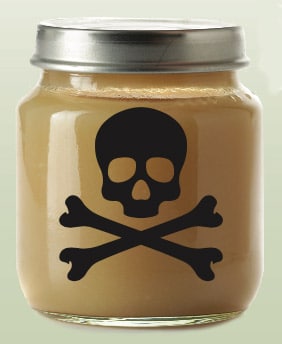
For generations, pediatricians have recommended rice cereal as a first food for babies in the transition to eating solids. Rice cereal is easy for babies to eat and is high in iron, an important nutrient for growing brains. However, recent research cited in Consumer Reports found persistently high levels of arsenic in rice and rice products, including infant rice cereal.
Rice tends to absorb more arsenic than other grains mostly because it is grown in water-flooded soil. When ingested, arsenic is highly toxic to humans, affecting IQ and neurodevelopment in babies and young children. Arsenic also ups the risk for several cancers (skin, bladder and lung), heart disease and type 2 diabetes in adults. Though regulations have been proposed, there is no federal limit for acceptable levels of arsenic in rice or rice products.
Is the danger grave enough to warrant eliminating rice from your diet? Perhaps, though if you aren’t quite ready to give it up altogether, some rice has less arsenic than others. Consumer Reports has found that rice varieties with the least arsenic include white basmati from California, India and Pakistan, and sushi rice from the U.S. Apart from sushi and quick-cooking rice, all types from Arkansas, Louisiana and Texas have among the highest levels of arsenic.
White rice is safer than brown, says Consumer Reports, because arsenic tends to accumulate in a grain’s outer layers—which are removed to make white rice. However, brown rice has more nutrients, so you may not want to give it up altogether. If rice is too much of a staple to limit severely, you can lower arsenic levels by about 30% by rinsing raw rice, using 6 cups of water to 1 cup of rice for cooking, and then draining the excess water.
When it comes to feeding babies, parents may want to ditch rice cereal and replace it with oatmeal or other grains such as bulgur, barley, farro, amaranth, buckwheat, millet and polenta, which all have very little arsenic.
Quinoa has some arsenic, but generally much less than rice.
Natalie Digate Muth, MD, MPH, RD
"Natalie Digate Muth, MD, MPH, RDN, FAAP, is a board-certified pediatrician and obesity medicine physician, registered dietitian and health coach. She practices general pediatrics with a focus on healthy family routines, nutrition, physical activity and behavior change in North County, San Diego. She also serves as the senior advisor for healthcare solutions at the American Council on Exercise. Natalie is the author of five books and is committed to helping every child and family thrive. She is a strong advocate for systems and communities that support prevention and wellness across the lifespan, beginning at 9 months of age."





